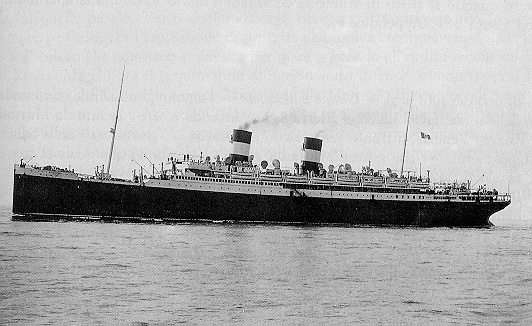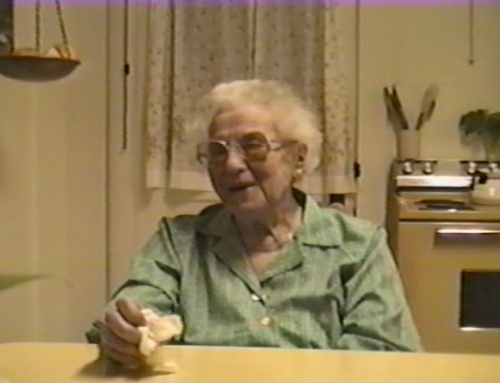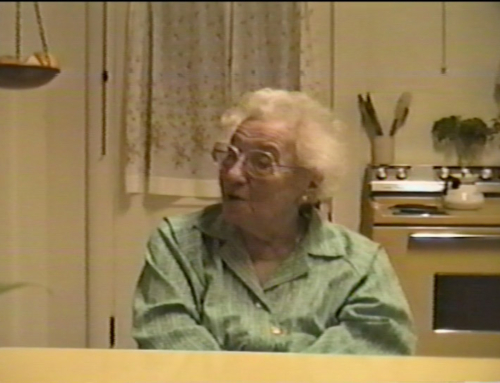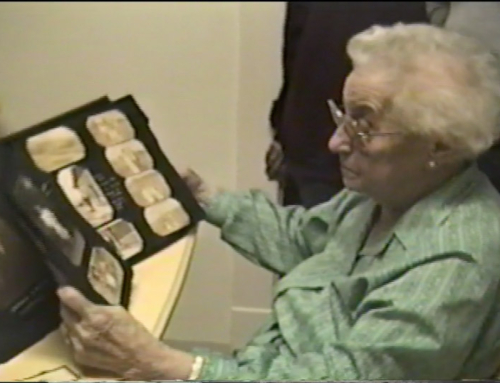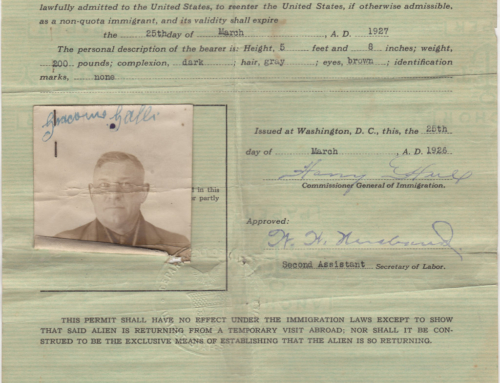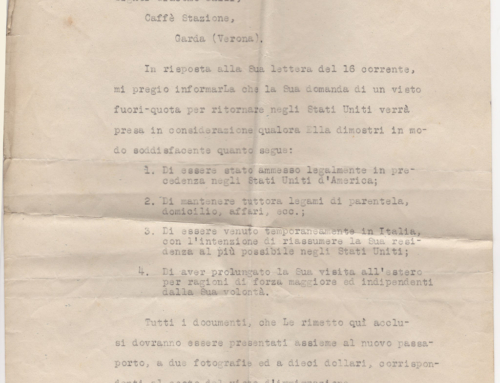Giacomo Galli – Born March 27, 1868 – Died 1928 at the age of 60
Erminia Galli Nevy (Mrs. Ralph Nevy) died March 4, 1992. In going through her belongings in her home at 779 Fayette Street, Cumberland, Maryland, Kristin Adolfson, one of her great-grand daughters, found a small leather case that had belonged to Erminia’s father, Giacomo Galli. It contained many old papers written in Italian. From these papers and from recollections of Erminia’s daughters, the following story is an attempt to reconstruct the last years of Kristin’s great great grandfather’s life.
Giacomo Galli was born to Francesco and Giovanna Martelli in Caprino Veronese. Caprino was a beautiful old hill town in Northern Italy, not far from Lake Garda, and 20 miles north of the ancient city of Verona in the foothills of the Italian Alps. He had 2 brothers, Luciano, who moved to Springfield, Massachusetts and Luigi, who settled in Detroit, Michigan. There may have been two other brothers, Angelo and Joseph and a sister Marianna. He and his brothers heard stories of the opportunities in the United States and wanted to seek their fortunes there.
Giacomo married Angela Fiorato of San Giorgio, another ancient hilltop village a few miles south of Caprino on April 3, 1898. Their marriage was blessed with two children. A daughter Erminia, born October 26, 1898 in Caprino Veronese, and a son Francesco Galli born in 1900. Documents say he died of natural causes on an unknown date.
When Erminia was 3, this small family came to America, to Colver, Pennsylvania, in a coal mining and farming area of western Pennsylvania. Giacomo continued making his living buying and selling farm animals in the area for butchering purposes.
Erminia, still a child, would accompany him on excursions to the surrounding farms to purchase animals. Frequently the farmer was out in the fields away from the farmhouse. Giacomo, sensing the housewife might not trust him would send young Erminia to the house. “Have you any cattle you want to sell?” The wife seeing the father and daughter together felt more comfortable. She could talk to this large imposing man who spoke with a foreign accent.
Giacomo had intended to become an American citizen and immigrate permanently to America, but love for his motherland, Italy, caused him to go back and forth across the ocean many times. He was constantly searching for a better way of life
Erminia remembered his once owning a bar in Pennsylvania. One night there was an awful drunken brawl in the bar. A man was shot. Giacomo’s wife, Angela, enveloped little Erminia in her skirt so she could not witness the bloody scene.
On one of their many family sailings to Italy, they stayed in a hotel on Lake Garda on their way to Caprino. Giacomo’s wife, Angela became very ill with a high fever. She died there of tubercular pneumonia, sometimes called galloping pneumonia, a common complication in those days. Erminia was eleven years old.
Giacomo and Erminia then sailed back to America. In time, her father longed to be married once more but this young daughter, still a child and having lost her mother, hung tenaciously to her father. When Giacomo asked her if he should marry one particularly fine lady, she screamed “No!” In her old age, Erminia had regrets that in her selfishness she denied him this pleasure. “What a foolish man, to listen to a young child.”
But eventually he did marry an Italian lady named Maria Vaona. His new wife bore him two daughters, Virginia and Christina. Giacomo and his second wife moved away from Caprino on March 27, 1917, to Lazise and then to Somma Campagna. By this time, Erminia, now 17, was working in a general store in Vintondale, Pennsylvania, a coal-mining town not far from Colver.
Vintondale was built at the head of a coal mine. There was a Catholic Church, a company store run by the mining company, and an Italian general store run by the Nevy family. These five Italian brothers and two sisters had started the store after coming to this mining town. Erminia worked in the store preparing grocery orders for the immigrant customers: Polish, Slav, Italian, Hungarian, Russian, learning enough in each language to manage. It was here she fell in love and married Ralph Nevy, the youngest son of this Italian immigrant family. They were married in nearby Colver, Pennsylvania January 12, 1915. She was 17 and he was 26.
Ralph Nevy was the handsomest and the youngest son of a family of 5 boys and 2 girls who had immigrated from Bergotto, Italy, a small village in the Apennine mountains between Parma and LaSpezia. When Ralph was still a young boy and shepherd in the hills above Bergotto, his father died in Marseille, France. He had gone there to find work to support his family. Ralph was the last of the children to leave the widowed mother in Bergotto and come to America. Eventually the old Nonna came to America also and live with her children in Vintondale.
Over the years we see few pictures of Giacomo in the Nevy photo albums. Giacomo’s second wife, Maria probably died in Italy. He sent her 5,000 Lire through the bank in Barnesboro, Pennsylvania on August 31, 1921. It was sent to the Catholic Bank in Caprino Veronese. By then Erminia was married and had 3 children, then eventually five in all, four girls and a boy. She lost contact with Giacomo’s two other children, and the families of Giacomo’s two brothers, Luciano and Luigi.
Erminia always said Giacomo was a tall man. In a passport issued in Genoa, Italy, February 21, 1923 he was recorded as having a high forehead, and was 5 foot 10 inches (1.75 meters) tall. He was robust and weighed 200 pounds. His hair was chestnut brown. Like many northern Italians from near the Alps, he had blue eyes with an olive complexion. He sometimes sported a mustache. A handsome man!
He returned from Italy in March of 1926, but was not well. He had a large swelling on the side of his neck. In June 1926, staying with his brother in Springfield, Massachusetts. He applied for yet another visa to go to Italy. He knew he had a serious health problem. The doctors here in America seemed at a loss to help him. He sought the opinion of doctors in Italy. Immigrants wanting to leave the country were given a visa valid for 6 months, at which time they must return if they still intended to become American citizens.
In December of that year, he entered into some sort of a financial arrangement with Elisa Pezzolato of Garda. It was a loan that he repaid for a time between January 26, 1927 and February 2, 1927. He fell in arrears, perhaps because he was admitted to a small hospital, Casa Di Cura, House of Healing, in Borgo Trento.
Dr. Chierego wrote a statement February 17, 1927 stating that Giacomo had a nemolyne tomporo occipitalis, a malignant tumor on the side and back of his skull. The doctor certified that the unfortunate man would be able to travel by ship to the United States by September of that year. Ten days later, another doctor at a small hospital on Lake Garda diagnosed it as a sarcoma, a rapidly growing cancer. The doctor recommended he enter his clinic at once for treatment.
Giacomo, realizing his visa would expire before he could complete the treatments, obtained a certificate verifying he was bed ridden and unable to use his ticket for sailing from Genoa to New York in April 1927 as planned. On April 1, 1927, his daughter Erminia sailed from New York for Italy with her husband, and their 2 youngest children, Gloria and Florence to visit relatives. They stayed until October or November of that year. Erminia had planned to spend much of the time with her relatives in Caprino or nearby San Giorgio while Ralph visited relatives in Bergotto.
However, Ralph was finicky when it came to food. He was not happy with the fare he was being given in his hometown of Bergotto. He sent a message to Erminia to leave her relatives and come cook for him in his town across the Po valley. We have no record of their visiting Giacomo on that trip, but they may well have.
For two months, from April 3, 1927 to June 5, 1927 Giacomo remained a patient in the hospital-clinic on Lake Garda, not far from Caprino Veronese. He received medications and injections. His receipts show he was charged extra for wine.
In May 1927 he wrote the American Consulate claiming he had lost his documents. Was this a ploy to stall for time? His daughter said years later that he could be a “horse trader.” He wrote to the American Consulate in Venice for advice. An American consular officer advised to get copies of his birth certificate, family ties, proof from the police that he was not wanted for any crimes, and that he had intended to return to America but was delayed by illness.
He was now anxious to return to his daughter Erminia’s home in United States. In several places, in pencil, he had written her married name, Nevy, and her address: 112 Wilmont Avenue in Cumberland, Maryland on the back of his documents.
In another desperate attempt for a cure, in November 1927 he visited yet one more physician, this one in Verona. The doctor had great credentials and was using radium, the newest treatment for tumors. His charges reflected his fame. After the treatments, Giacomo contacted travel agents seeking passage to New York. Time was running out and he knew it. He must make his move now if he was to reach Cumberland and his daughter.
There was also the matter of debt between him and Elsie. She said she would wait no longer. In December 29, 1927, she brought legal pressure to make him repay his debt. An eviction notice was served on him. His furniture was sold at the door of his house and the money given to her.
On January 16, 1928, he received news from his travel agent that he had a ticket to sail to United States. He had a third class cabin on the Italian Ship, Roma (at left), and leaving Genoa February 21, 1928. The passage, with a stop in Naples, would take ten days. The steamship company sent him a list of meals he could expect and the prices. His tumor was growing rapidly and he was probably aware of his appearance. He was anxious to depart.
His last two nights in his beloved Italy were spent in a cheap hotel in Genoa, where he had previously stayed. The ship sailed from Genoa February 21, 1928 with this ailing man aboard. In March 1928 he would be 60 years old. We have no documentation of how this crossing went in the middle of winter in a third class cabin but we can assume it was a rough passage.
The last document in the old small leather case was a pink Pullman ticket stub for the Baltimore and Ohio (B&0) Railroad dated March 6, 1928, Jersey City, N.J. He had to ferry across the Hudson to the terminal. The B&O left Jersey City and, by way of Washington D.C., arrived at Cumberland, Maryland and the home of his daughter, Erminia where she lived with her husband, Ralph and five children: Inez, Aldo, Viola, Florence, and Gloria. Inez, the oldest was eleven and Gloria was three.
The paper trail ends here. There are a few memories from his grandchildren.
Inez remembers his visiting the family when they lived on Thomas Street, across from the Cumberland Macaroni Factory the Nevy brothers had established in 1919. They lived on the second floor of a large brick two-family house. The oldest Nevy brother, Henry lived on the first floor with his wife Caterina and daughter Linda and son Robert.
Inez recalls having a loose lower front tooth. Erminia tied a string around the tooth and the other end to a doorknob in order to remove it. “It didn’t work. I was crying profusely. Mother removed the string from the doorknob. I clutched the end of the string and walked about sobbing. Nonno came up to me, stooped down and asked: Cosa ti fai, Putina? (WhatÕs the matter, little girl?) While I explained, in English about the door episode he pulled the string and the tooth went flying. I screamed and he grabbed and hugged me, trying to settle me back to smiling. I was so relieved that it was out. Mother’s reward was to get me a new coat and hat. I had to be about 5 or 6 years old because when we moved to ll2 Wilmont Avenue l was 7. Mother adored her father.”
Viola remembers his arrival at their home on Wilmont Avenue late one night. He tiptoed into the bedroom of the sleeping children. He did not stay in their home. He didn’t want the children to see his deformed face. The tumor was getting much larger. Erminia realized death was approaching for her father and further treatment was hopeless, but he wanted yet another opinion. He told her of a renowned specialist in Baltimore. When Erminia balked at the idea of yet another useless exam, he accused her of not wanting to help him now that his finances were depleted. So she took him to Baltimore. Nevertheless, by this time his fate was sealed.
They returned to Cumberland. He insisted she find him a place to stay; he didn’t want to frighten her children. She placed him in the home of Miss Cross in South Cumberland. Miss Cross was the kind nurse who had helped with the birth and care of all Erminia’s children. Erminia visited him daily until his death in late spring of 1928.
Inez remembers his being “laid out” in the living room at Wilmont Avenue in Cumberland, a common practice in those days. You knew what it meant when you saw a large black ribbon on the door of a house before the funeral.
Giacomo is buried in the cemetery of Saints Peter and Paul Catholic Church on Fayette Street, next to his daughter, Erminia, her husband, Ralph, their child Gloria, who died in early childhood, and other family members.
–Written and Compiled by William H. Orsinger, M.D

